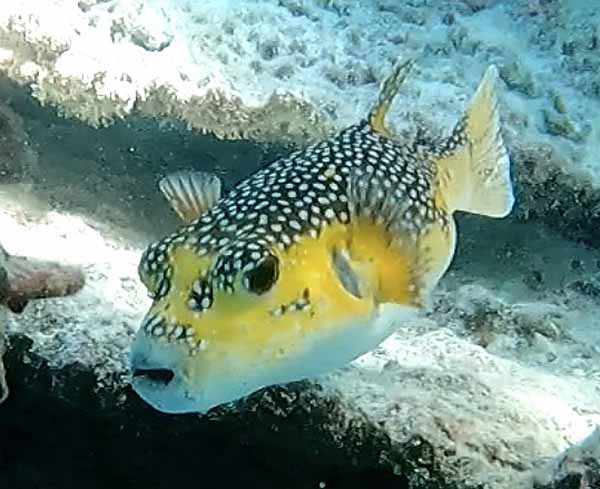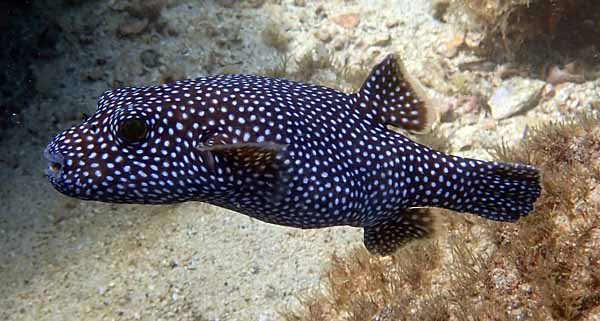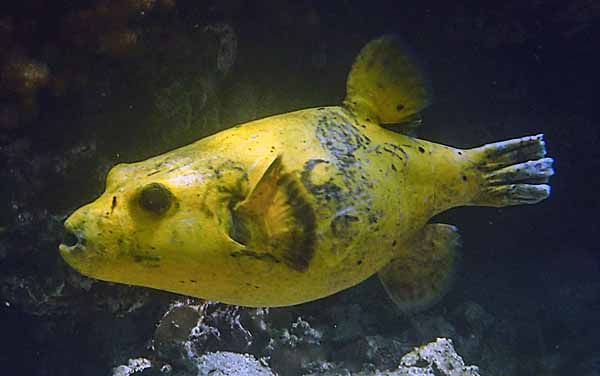Arothron meleagris
(Anonymous in Lacepède, 1798)
|
Familie: Tetraodontidae SynonymeTetrodon meleagris Anonymous, 1798
Tetraodon lacrymatus Quoy & Gaimard, 1824
Ovoides latifrons Jenkins, 1901 Lokale Bezeichnung |
 Arothron meleagris (Oceanien, Kleinere amerikanische Überseeinseln, Johnston) -- (C) Ryan Rash; iNaturlaist; BY-NC 4.0 |
Typen
Keine Typusexemplare bekannt .
Siehe: Eschmeyer, W.N., Fricke, R. & Van der Laan, R. (eds.) 2024. Catalog of Fishes electronic version
Typusfundort: Asiatische Meere [Indo-West-Pazifik].
Etymologie
Meleagris (= Perlhuhn), bezogen auf die unzähligen weißen Flecken auf dem Körper, die dem Farbmuster eines Perlhuhns ähneln. (Übersetzt aus: The ETYFish Project)
Verbreitung
Indo-Pazifik: Ostafrika, Sokotra, Seychellen, Komoren und Madagaskar, östlich bis zu den Hawaii-Inseln (U.S.A. ), nördlich bis zu den Ryukyu-Inseln und den Ogasawara-Inseln, südlich bis zur Lord-Howe-Insel, Neukaledonien und der Osterinsel; im östlichen Pazifik von der südlichen Baja California Sur (Mexiko) südlich bis Ecuador, einschließlich des südlichen Golfs von Kalifornien (Mexiko), der Revillagigedo-Inseln (Mexiko), der Clipperton-Insel (Frankreich), der Cocos-Insel (Costa Rica), der Malpelo-Insel (Kolumbien) und der Galapagos-Inseln (Ecuador).
IUCN Status

EX Extinct (ausgestorben)
EW Extinct in the Wild (in der Natur ausgestorben)
CR Critically Endangered (vom Aussterben bedroht)EN Endangered (stark gefährdet)
VU Vulnerable (gefährdet)
NT Near Threatened (potenziell gefährdet)
LC Least Concern (nicht gefährdet)
RE Regionally Extinct (regional oder national ausgestorben)DD Data Deficient (ungenügende Datengrundlage)
NE Not Evaluated (nicht beurteilt)
LC Least Concern (nicht gefährdet)
Gefahren für diese Art: Siehe IUCN
Literatur
- Anonymous [Lacepède] 1798. Paris b. Plassan: Histoire naturelle des poissons par le Cit. La Cepède, etc. (Beschluss der im vorigen Stücke abgebrochenen Recension). Allgemeine Literatur-Zeitung 1798 (pt. 3) (no. 288): cols. 681-685. (PDF) Zitatseite [:684, Autor: Anonymous !!, als Tetrodon meleagris]
- Lacepède, B.G.E. 1798. Histoire naturelle des poissons. 1: 1-8 + i-cxlvii + 1-532, Pls. 1-25, 1 table. Zitatseite [:505, als 'Le tétrodon méléagris']
- Quoy, J.R.C. & Gaimard, J.P. 1824-25. Description des Poissons. Chapter IX. In: de Freycinet, L.: Voyage autour du Monde...exécuté sur les corvettes de L. M. "L'Uranie" et "La Physicienne," pendant les années 1817, 1818, 1819 et 1820. Paris. 192-401 [1-328 in 1824; 329-616 in 1825], Atlas pls. 43-65. (BHL) Zitatseite [:204, !!, als Tetraodon lacrymatus]
- Cope, E.D. 1871. Contribution to the ichthyology of the Lesser Antilles. Transactions of the American Philosophical Society, (New Series) 14 (3) (art. 5): 445-483. (BHL) Zitatseite [:479, !!, als Arothron ophryas]
- Jordan, D.S. & Gilbert, C.H. 1883. List of fishes now in the museum of Yale College, collected by Prof. Frank H. Bradley, at Panama, with descriptions of three new species. Proceedings of the United States National Museum, 5 (329): 620-632. (BHL) Zitatseite [:631, !!, als Arothron erethizon]
- Smith, R. 1886. On Tetraodon setosus, a new species allied to Tetraodon meleagris Lacép. Bulletin of the California Academy of Sciences, 2: 155-156. (BHL) Zitatseite [:155, !!, als Tetrodon setosus]
- Jenkins, O.P. 1901. Descriptions of fifteen new species of fishes from the Hawaiian Islands. Bulletin of the U. S. Fish Commission, 19[1899]: 387-404. (BHL) Zitatseite [:398, Fig. 10, !!, als Ovoides latifrons]
- de Graaf, F. 1977. Tropische Zierfische im Meerwasseraquarium. Verlag Neumann-Neudamm, Melsungen. 1-468. Zitatseite [:277|Farbfoto, Synonyme, Vorkommen ]
- Su, J.-X. & Tyler, J.C. 1986. Diagnoses of Arothron nigropunctatus and A. meleagris, two extremely polychromatic Indo-Pacific pufferfishes. Proceedings of the Academy of Natural Sciences of Philadelphia, 138: 14-32. Zitatseite [:27, Arothron erethizon, Ovoides latifrons, Arothron ophryas u. Tetraodon lacrymatus als Synonyme]
- Moosleitner, H. 1989. Indische Kugelfische. Die Aquarien- und Terrarienzeitschrift (DATZ), 42 (10): 603-605. Zitatseite [:603f|Farbfoto, Vorkommen ]
- Grove, J.S. & Lavenberg, R.J. 1997. The fishes of the Galápagos Islands. Stanford University Press, Stanford. i-xliv + 1-863, 32 pls. Zitatseite [:646, Tetrodon setosus als Synonym]
- Schneidewind, F. 2000. Farbige Kugeln. Polychromatismus bei Kugelfischen. Aquaristik Fachmagazin, #154, (Aug./Sept.): 2-6. Zitatseite [:3f|Farbfoto, Farbfoto, Farbfoto ]
- Hebbinghaus, R. 2000. Verkannte Giftfische: Kugelfische & Co. Die Aquarien- und Terrarienzeitschrift (DATZ), 54 (1): 18-19. Zitatseite [:18-19|Farbfoto, Physiologie, Gift ]
- Frische, J. & Finck, H. 2008. Rund und eckig, rau und stachelig - Kugelfische und ihre Verwandten. Die Aquarien- und Terrarienzeitschrift (DATZ), 61 (5): 44-47; (II): (6): 35-39. Zitatseite [:45*|Farbfoto, Aquarienhaltung ]
- Hebbinghaus, R. 2022. Kesse Schnauze, runder Bauch - Spitzkopfkugelfische! Die Aquarien- und Terrarienzeitschrift (DATZ), 75 (2): 24-31. Zitatseite [: 30*, Farbfoto, Giftigkeit]

